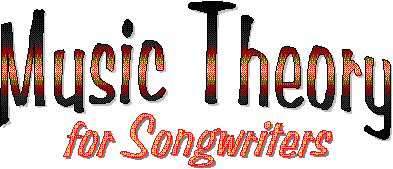



Concept #9 - Chords From Other Keys
When we left Part Four, we were just about to discuss Secondary Chords. These are chords borrowed from other keys. Let's explain it this way.
Have you ever visited a Water Park with pools and slides? Let's take our Simple Map and use our imagination. First, I'm going to change the simple map from I, ii, iii, IV, V, vi to C, Dm, Em, F, G, and Am. These are the chords for the key of C. Second, I'm going to make each square in the diagram a "pool" in our imaginary Water Park. Got it?
Do you remember the rules? You may jump anywhere from I, which in this case is C. If a chord appears at more than one place (like Dm or G), there is a "secret tunnel" connecting them, so being at one spot is the same as being at the other.
But this time we add a new rule. At any time you may leave the water to come down a slide. Where are the slides? Here they are!
Okay... we have a few things to talk about.
1. First, let's talk about the blue boxes. Some of the chord variations now appear at the bottom of each box. For instance, C lists the 2 chord, the 6 chord, major 7, major 9, and suspended as possible options.
2. Three blue locations have been added. The octagon with C/G inside indicates that this chord quite often follows Dm or F, and then heads for G before going home to C. The box labeled F/C and G/C shows that the right hand chord can change while the bass note (C) stays right where it is. This technique, holding a bass note while varying the chord above it, yields many surprising and useful sounds. Finally, the little box labeled C/E is often found between F and Dm. It works going either way.
3. The chords with a green background don't belong to the key of C; they come from other keys. They are useful when we want to "step further out." You can put a green chord almost anywhere, but when you do, you'll probably want to follow the arrows back toward the blue ones. Your audience will feel good when the chords that seem "far from home" step back to more familiar ground.
(A word about names - Some of the green chords are written as slash chords, like Am/F#. This chord could also be written F#m7b5. In general, whenever you take a simple minor chord and move the bass from the root down three half steps, you get a m7b5 on the new bass note. Sometimes calling it Am/F# is easier for me.)

Just as before, your challenge is the same. See how many short progressions you can create. Start anywhere. Then follow the arrows. If you do these simple exercises, you'll soon gain a greater understanding of the chords available to you, and also how they move naturally from one to another.
Updated Information - Interactive, Playable Maps
Just so you know, we now have a program (which runs on Windows PC's) that allows you to click on a map and hear the chord as well as see it displayed on a virtual keyboard. This program is especially helpful for music theory students, songwriters who have never had a chance to take music theory courses, and anyone learning to play the piano by ear. The program is described at another site called MusicToolsForPeople.com. If you are interested in exploring lots of chords by clicking with a mouse, click on the image below.

Let's Review
You've reached the end of Part Five. In this section we imagined our Simple Map as being a group of pools, each one with slides flowing into it. These slides allow you to choose a chord outside the key and come back smoothly to more familiar sounds. We also added a few new ideas to the simple part of the map.
With all of these chord possibilities, you have a lot of room to explore and practice. Spend some time learning, and your music will show the difference.
Have fun!
This way to Charts and Maps and then on to Part 6.
Index - Part 1 - Part 2 - Part 3 - Part 4 - Part 5 - Charts and Maps
Part 6 - Part 7 - Part 8 - Part 9 - 1st Steps in Keyboard - Part 10
Part 11 - Part 12 - 1st Steps in Note Reading
Copyright 2004 Steve Mugglin
Permission is given to make not-for-profit copies
of this material.